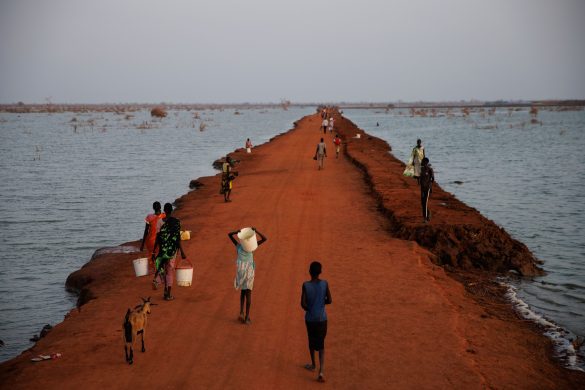Journalister tager igen klodens klimaudfordringer alvorligt. Internationalt var der 30 % mere dækning af klimaet i 2013 end det foregående år – den første stigning siden 2009. Klimaet bliver særligt koblet sammen med energi og vejr.
Det skriver The Daily Climate torsdag.
Coverage of climate change issues jumped in 2013, fueled by reporting on energy issues – fracking, pipelines, oilsands – and a heavy dose of wacky weather worldwide.
The climb, 30 percent above 2012 levels, marks the end of a three-year slide in climate change coverage and is the first increase in worldwide reporting on the topic since 2009, based on analysis of The Daily Climate’s aggregation database.
Last year The Daily Climate aggregated 24,000 news articles, opinions and editorials on climate change from “mainstream” media outlets globally. That’s well above the 2012 low of 18,546 stories, but still below the highs from 2007 through 2009, when the Daily Climate aggregated an average of nearly 29,000 a year.
“The climate issue is not seen anymore as something that lives inside a green bubble,” said David Sassoon, editor of the Pulitzer-prize winning news site Inside Climate News.
More and more, he said, climate change “is intimately connected to every major energy and extreme weather story you’d care to look at. The dots are finally being connected more responsibly, something that’s long overdue.”
More ink in 2013
Most major outlets gave climate and energy issues far more ink in 2013 than 2012: Bloomberg News was up 133 percent, the Globe and Mail doubled its reporting, USA Today boosted its effort 48 percent and stories in the Wall Street Journal, Sydney Morning Herald and the Financial Post each were up 40 percent, according to The Daily Climate’s archives.
Of the world’s news outlets, Reuters led the pack in climate change coverage, with almost 1,100 news stories. Associated Press was second, with 1,030, followed closely by The Guardian, with 1,025.
The New York Times, having dismantled its “green desk” in early 2013, was the only major publisher to see coverage drop in 2013
The New York Times, having dismantled its “green desk” in early 2013, was the only major publisher worldwide to see coverage drop in 2013, dipping 10 percent from 2012’s level to 883.
The Daily Climate is an independent, foundation-funded news service that has aggregated climate coverage since 2007. The aggregation is meant to provide a broad sampling of the day’s coverage, not a comprehensive list.
Niche journalism
A growing universe of niche and mostly online publications such as Inside Climate also fueled the overall rise in climate coverage, media experts and the Daily Climate’s database suggest.
“Our work infiltrated in ways we never dreamed of,” Sassoon said. “I can’t say that our work has had a big influence on the uptick in the raw number of climate stories. But it is pretty evident to us that we’ve changed the quality and the substance of the national discourse.”
But that metric – how or whether the uptick in coverage has changed public opinion on climate change – is far more difficult to assess.
“When you look at public opinion data, it’s still the nightly news, believe it or not. That’s still the single biggest driver,” said Robert Brulle, a social scientist at Drexel University who monitors climate coverage and has spent time plumbing the depths of the Daily Climate’s archives.
US Newspapers-575Brulle’s tracking of TV news shows climate coverage was stable last year, with nightly news at ABC, NBC and CBS airing 30 stories, compared to 29 in 2012.
Nightly news’ impact
Brulle also works with media watchers at the University of Colorado who track climate change coverage in major news newspapers worldwide. That team’s data show a decline in coverage among the top five newspapers in the United States.
But those trackers, unlike The Daily Climate’s aggregation, count a story only if the words “global warming” or “climate change” appear.
“So a story all about the politics of Keystone, or Bill McKibben (founder of 350.org) and his struggles with the White House, aren’t going to show up in our search,” Brulle said.
Those stories would be picked up by the Daily Climate’s team of part-time researchers, who scour the web twice daily.
Drawing links to climate change
On many fronts more reporters are drawing links among energy security, environmental impacts and a changing world – even if they don’t use the term “climate change.”
Energy stories saw the biggest jump of any of the several categories The Daily Climate tracks. Oil infrastructure and pipeline safety became a key climate story in 2013
“It’s a huge story,” said Jeremy Schulman, senior project manager of Climate Desk, a collaboration of several media outlets including Mother Jones, the Atlantic, Wired and the Center for Investigative Reporting.
“It goes beyond typical environmental stories…. You have national security, or sports or entertainment.”
“It should be treated as the new baseline that affects all stories,” he added, noting that Grist columnist David Roberts, in an August essay, called for climate change to be freed from the “straightjacket” of the environmental beat.














